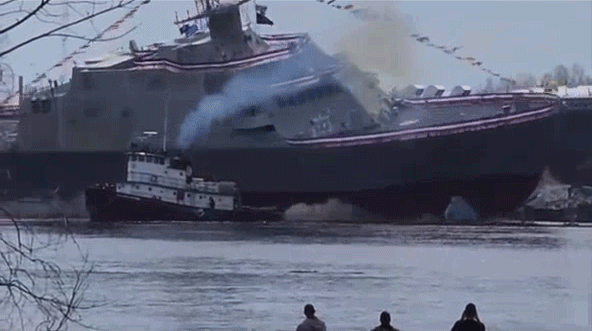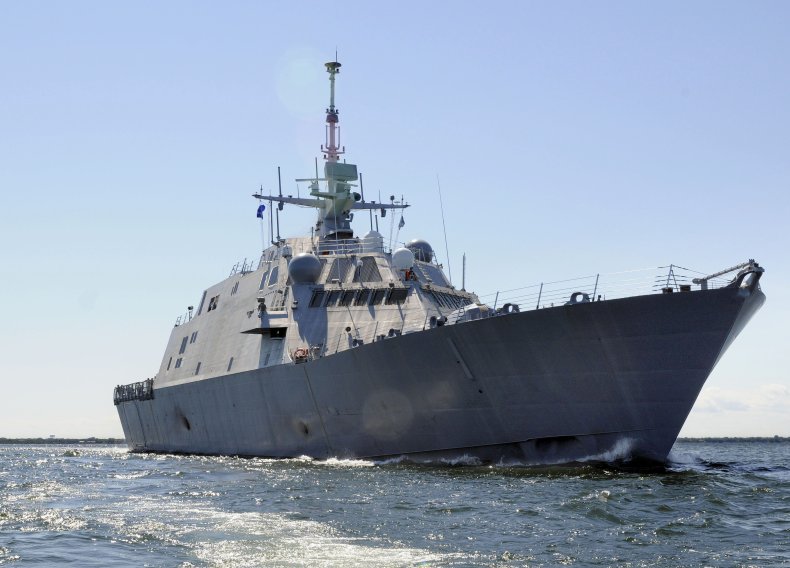美国新军舰刚刚下水就被撞毁,打脸了谁?
众所周知,美国正在经历本世纪最严重的经济危机,美债到期不能兑付这在美国200多年历史上,还是空前的,与此同时,美军各方面的军事失败也在摧毁“三位一体”帝国架构的最后一根支柱……
Launch of brand new U.S. warship goes away

从苏丹撤侨就能看出,美国海军不敢行动,白宫负责人告诉各大媒体“我们只能先撤走大使馆官员,其他的数以万计美国人只能自己寻求避难…”再加上之前在阿富汗、叙利亚、索马里一带的拉胯表现,美军,让世界各国发现,它其实非常虚弱。
所以,五角大楼也很着急,为了“尽快弥补”美国海军战力的不足,它要求美国军工体系“尽快”让新的军舰下水,以应对美军装备普遍老化和可用舰艇总规模不足的窘境。好了,问题来了,越是着急,事故就会越多……

4月下旬,据美国Newsweek放出的视频,一艘新的美国海军军舰在一次“戏剧性”的下水过程中,与一艘美军的拖船相撞,然后翻进了海里。
美国海军曾在周五证实,将“命名并发出”最新型的海军自由变种LCS,即濒海战斗舰,以应对“即将开战”的需求。很快,海军公布了“大跃进式快速下水”的舰艇名称:即美国克利夫兰号(LCS 31)。该船于当地时间周六上午10点在威斯康星州的Fincantieri Marinette海军造船厂下水。据美国海军称,这是威斯康星州军事码头在升船系统彻底就位之前,最后一次预定的侧翼下水仪式。
在欢呼声中,船只慢慢启航,但美国海军克利夫兰号立即向一侧倾斜,并在拖船上掀起巨浪。军方调查称“是绳子太短、拖船太少”导致……后来又说,可能极端天气也要承担责任。但从视频的细节看,撞击现场根本没有大风,甚至没有浪……打脸的是,曾经,美国海军是准备要上两艘以上拖船来让庞大的军舰下海,但后来又因为“准备不足”,只上了一艘拖船,而且,神奇的是,拖船似乎真的“因为绳子太短”是从侧面在拖拽军舰……
从军方含糊其辞的声明来看,这次“下水仪式”是彻底的失败。更加失败的是,军方的调查报告不敢也不能查出真正的事故原因。将责任推给拖船太少、驾驶员“不专业”和“绳子太短”,都是非常不负责任的操作。
有趣的是,海军部长卡洛斯·德尔·托罗在下水活动前一天的新闻稿中还表示:此次下水仪式“将是它加入我们的舰队、在公海远航、继续保卫我们的国家和快速投入战斗又近了一步,代表着我们的美国海军与克利夫兰市的紧密联系”。部长并没有胡说,因为美国海军将LCS级舰艇描述为“快速、载人最佳、执行远洋(作战)任务量身定制的水面战斗舰艇”,能够在近海和公海和“敌人”战斗。
海军部还解释说,LCS级舰艇有两种变体,即自由号和独立号,主要区别在于单体和多体系统设计。但由于这是美军大跃进式“快速建造”以及“快速投入战斗”的舰艇,五角大楼专家们对这些作战单位的持续使用存在分歧,这些“新生代”军舰一直受到“可靠性问题”的困扰,这意味着,它们很可能不是“一个巨大的成功案例”。
沙利文昨天的演说确实很“诚恳”,花街金融界的操作,真的蛀空了美国的制造业,这其中甚至包括和军事有关的重工业。以至于拜登想要加紧备战,下边都执行不好。当然,海军部的调查报告也可以写得更华丽一些,比如,我们需要更多经费以应对可能的事故和灾难,这样就能再添一笔收入了……数十年来,美国的天价军费不就是这样被吃掉的么?
Launch of Brand New U.S. Warship Goes Awry
Anew U.S. Navy warship appeared to collide with a tugboat during a "dramatic" launch of the vessel.
The U.S. Navy said on Friday that it would "christen and launch" the latest Freedom-variant LCS, or Littoral Combat Ship, which would be known as the U.S.S. Cleveland (LCS 31). The ship launched at 10 a.m. local time on Saturday at the Fincantieri Marinette Marine shipyard in Wisconsin. It was the last scheduled side launch of a ship at the Wisconsin shipyard before a ship lift system is put in place, according to the Navy.
In footage purportedly showing the event, the new LCS appears to collide with the tugboat that aided the launch. Amid cheers, the boats slowly take off, only for the U.S.S. Cleveland to immediately tilt to the side and send a wave crashing over the tugboat. It's unclear if the warship slammed into the tugboat, or if it was sent backward because of the force of the wave.
 The U.S.S. Freedom (LCS 1) is shown during day one of the ship's builders' trials on July 28, 2008. On April 14, the U.S. Navy said it would "christen and launch" the latest Freedom-variant LCS, or Littoral Combat Ship, which would be known as the U.S.S. Cleveland (LCS 31).LOCKHEED MARTIN/GETTY IMAGES
The U.S.S. Freedom (LCS 1) is shown during day one of the ship's builders' trials on July 28, 2008. On April 14, the U.S. Navy said it would "christen and launch" the latest Freedom-variant LCS, or Littoral Combat Ship, which would be known as the U.S.S. Cleveland (LCS 31).LOCKHEED MARTIN/GETTY IMAGES
"No personnel injuries occurred, but there was limited damage to LCS 31," the spokesperson added.
"The damaged area is well above the waterline and no flooding occurred," but an "assessment was completed and permanent repairs are being planned."
Root cause of the incident is currently under investigation by the Navy and shipbuilder," they continued.
Mark Grove, a senior lecturer at the University of Lincoln's Maritime Studies Center at the Britannia Royal Naval College Dartmouth, told Newsweek that the tugboat is there to "pull" the ship into the water, working with gravity to side-launch the new vessel in what is "the most dramatic" and an "old-fashioned" form of launching.
It is typically used when there is not sufficient water to launch the vessel stern-first down a slipway, Grove said, and vessels will usually need to be designed with this specific launching technique in mind.
The ship, which is the fourth to be named after the Ohio city of Cleveland, is the 16th—and final—Freedom-class LCS.
The launch "will be another step closer to joining our fleet, sailing the open seas, continuing to defend our nation, and representing the strong connection our Navy has with the city of Cleveland," Carlos Del Toro, Secretary of the Navy, said in a press release ahead of Saturday's event.
LCS-class vessels are described by the U.S. Navy as "fast, optimally-manned, mission-tailored surface combatants," able to navigate near-shore waters as well as the open ocean. There are two variants of LCS class ships, known as Freedom and Independence, with the key difference being the monohull and multihull designs, Grove said.
They are designed to be relatively small, fast and inexpensive vessels, with a small number of crews operating the highly maneuverable ship. Experts are split on the continued usefulness of the vessels, which have been plagued by "reliability issues," meaning they have not been "a huge success story," Grove said.